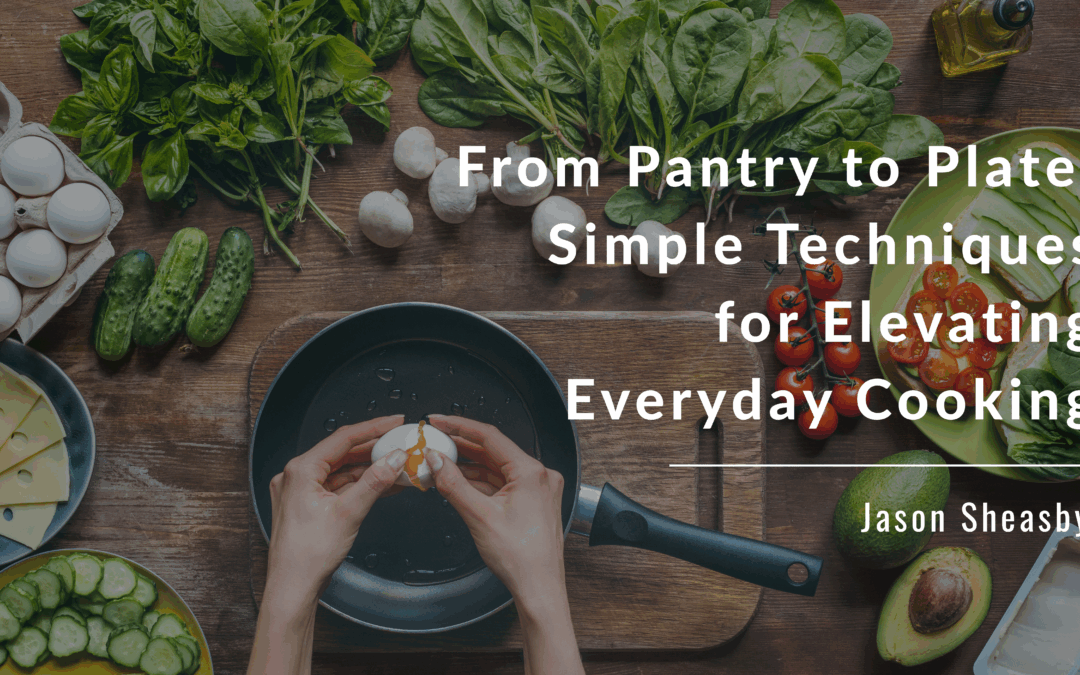
In today’s busy world, many of us rely on quick meals, takeout, or pre-packaged foods to satisfy our hunger. But cooking doesn’t have to be complex or time-consuming to be satisfying and delicious. With a few simple techniques and a well-stocked pantry, you can transform everyday ingredients into flavorful, elevated meals. The beauty of cooking at home is that it gives you full control over what you’re eating. You can make dishes that are not only healthier but also tailored to your personal taste preferences. In this article, we’ll explore easy, effective techniques to elevate your everyday cooking and make your pantry your best kitchen companion.
1. Stocking Your Pantry with the Right Essentials
The first step in elevating your cooking is ensuring you have the right basic ingredients on hand. A well-stocked pantry is a game-changer for any home cook. You don’t need an extensive list of exotic ingredients to start cooking delicious meals—just a few versatile, high-quality items can go a long way.
Here are some pantry staples to always have on hand:
-
Olive oil: A great base for cooking and dressing salads, olive oil is rich in healthy fats and imparts a delicious flavor.
-
Spices and dried herbs: Stock up on basics like garlic powder, paprika, cumin, oregano, thyme, and basil. These will help you create depth and complexity in your dishes.
-
Canned tomatoes: A versatile ingredient for soups, stews, sauces, and casseroles.
-
Rice and pasta: These ingredients are filling, and you can use them in countless recipes, from stir-fries to pasta dishes.
-
Beans and lentils: A great source of plant-based protein, they’re perfect for making hearty stews, soups, and salads.
-
Vinegar (balsamic, red wine, or apple cider): Adds acidity to balance flavors and is perfect for dressings, marinades, and deglazing pans.
2. Understanding Flavor Building: The Power of Layering
One of the most effective ways to elevate everyday cooking is to master the art of layering flavors. This means thinking about how to combine different tastes and textures to create a dish that is rich and complex. In many home kitchens, dishes can taste flat or one-dimensional because they miss this key element.
Here are some ways to layer flavor:
-
Sauté your aromatics: Onions, garlic, ginger, and herbs are foundational flavors in many cuisines. Always start by sautéing them in oil or butter. This caramelizes the natural sugars and creates a savory base for your dish.
-
Season in stages: Don’t wait until the end of cooking to season your dish. Season your ingredients as you cook, tasting and adjusting the flavors as you go. This ensures the seasonings penetrate and flavor every part of the dish.
-
Incorporate acidity: A splash of vinegar or a squeeze of citrus can balance out the richness of a dish. For example, adding a splash of balsamic vinegar to a pasta sauce or a squeeze of lemon to roasted vegetables brightens the flavors and adds depth.
3. Perfecting Your Cooking Methods
It’s not just about what ingredients you use but also how you cook them. Elevating your cooking often comes down to choosing the right method for the dish and ingredient. Even with basic ingredients, the right cooking technique can transform a simple meal into something extraordinary.
Here are some methods to master:
-
Roasting: Roasting is an easy and hands-off technique that intensifies flavors. Roasting vegetables like carrots, sweet potatoes, or Brussels sprouts caramelizes their natural sugars and brings out their sweetness. It’s an easy way to add flavor to your plate without much effort.
-
Searing and browning: Whether you’re cooking meat or vegetables, searing them in a hot pan until they develop a rich brown crust adds flavor. This Maillard reaction creates a deep, savory taste that takes your dishes to the next level.
-
Simmering: Long, slow cooking is the secret to developing deep, complex flavors in soups, stews, and sauces. For example, when making a tomato sauce or soup, letting it simmer for an hour or more allows the ingredients to meld together and creates a richer, more flavorful base.
4. Adding Texture with Simple Components
In addition to flavor, texture plays a crucial role in creating satisfying dishes. A balanced combination of different textures can make even the simplest dish more exciting.
Here’s how you can introduce variety in texture:
-
Crunch: Adding a crispy element to your dish makes it more dynamic. Try adding toasted nuts, breadcrumbs, or croutons to salads or soups for an added crunch.
-
Creaminess: A creamy sauce or mashed potatoes can complement a dish by adding smoothness and richness. You can make a simple sauce by combining cream, butter, and herbs, or use ingredients like avocado or Greek yogurt for a healthier alternative.
-
Freshness: Fresh vegetables like cucumbers, tomatoes, or leafy greens can offer a contrast to richer elements like meats or creamy sauces, providing balance to the meal.
5. Incorporating Herbs and Spices
Herbs and spices are your secret weapon for elevating everyday meals. They’re easy to use and can drastically change the flavor profile of your dish, making it more complex and vibrant. Don’t just rely on salt and pepper to season your food—experiment with other spices to enhance and elevate the flavors.
-
Herbs like basil, thyme, rosemary, and cilantro can be added to dishes just before serving to brighten and refresh the flavor.
-
Spices like cumin, smoked paprika, turmeric, and cinnamon can add warmth and earthiness to your cooking. Try incorporating these into stews, soups, and even grains like rice or quinoa to infuse them with new flavors.
6. Creating Homemade Sauces and Condiments
Sauces and condiments are a great way to elevate any dish. Instead of relying on pre-made bottles of ketchup, mayonnaise, or store-bought dressings, try making your own. Not only are homemade sauces more flavorful, but they also give you control over the ingredients.
Simple homemade sauces include:
-
Pesto: A blend of fresh basil, garlic, pine nuts, Parmesan, and olive oil, pesto is perfect for pasta, sandwiches, or as a drizzle over roasted vegetables.
-
Vinaigrette: A basic combination of vinegar, oil, mustard, and seasonings, vinaigrettes are easy to whip up and can be customized with various herbs and spices.
-
Tomato sauce: A slow-simmered sauce with garlic, onions, and herbs is perfect for pasta or as a base for pizza. Making your own allows you to control the seasoning and sweetness of the sauce.
7. Making the Most of Leftovers
Another great way to elevate your cooking is by making the most of leftovers. Instead of letting food go to waste, use leftovers creatively to build new meals.
Here are some ideas:
-
Turn roasted vegetables into soups: Puree leftover roasted vegetables with broth for a creamy, comforting soup.
-
Transform cooked grains into salads: Leftover rice or quinoa can be the base for a fresh, grain salad. Toss in vegetables, nuts, and a simple dressing for a quick, flavorful meal.
-
Repurpose meats: Leftover roast chicken can be turned into tacos, soups, or sandwiches. Similarly, leftover steak can be used in stir-fries or wraps.
8. Mindful Meal Planning
Meal planning is an essential aspect of cooking with purpose. When you plan ahead, you’re more likely to use your pantry ingredients effectively, reduce food waste, and create meals that are well-balanced and satisfying. Spend a little time each week planning your meals around pantry staples, fresh produce, and proteins you already have on hand.
Consider the following tips for effective meal planning:
-
Plan versatile meals: Choose dishes that can be easily modified based on what’s in your pantry. For example, a simple pasta with tomato sauce can be transformed into a vegetable stir-fry with the addition of a few spices and herbs.
-
Batch cooking: Prepare larger quantities of meals like soups, stews, or grains and store them in the fridge or freezer for later. This saves you time throughout the week and ensures you have healthy meals readily available.
9. Balancing Nutrients and Flavors
Cooking with purpose means thinking about the nutritional balance of your meals. Incorporate a variety of vegetables, whole grains, proteins, and healthy fats to create dishes that not only taste good but also fuel your body. A well-balanced meal includes fiber, healthy fats, protein, and carbohydrates, all working together to give you sustained energy.
You can elevate your meals by balancing:
-
Vegetables: Aim for a colorful variety of vegetables to provide a wide range of nutrients.
-
Proteins: Include lean proteins like chicken, fish, or plant-based options like beans and tofu.
-
Healthy fats: Avocados, olive oil, and nuts are great sources of healthy fats that add flavor and richness.
10. Enjoying the Process
Finally, the most important element of cooking with purpose is enjoying the process. Cooking should be a joyful, creative experience where you get to experiment and discover new flavors. Take your time, listen to your ingredients, and embrace the opportunity to make something from scratch. The more you practice, the better you’ll get at understanding how to build flavors and elevate your everyday meals.
Conclusion
Cooking with purpose doesn’t mean you have to spend hours in the kitchen or use exotic ingredients. By focusing on quality ingredients, layering flavors, using simple techniques, and thinking creatively, you can elevate everyday cooking and turn even basic meals into flavorful experiences. The key is to be mindful of the flavors you’re creating and how they interact with each other. With a little practice, your pantry can become a treasure trove of possibilities, transforming the way you cook and enjoy food every day.

